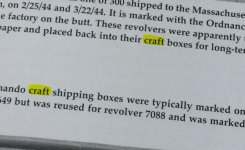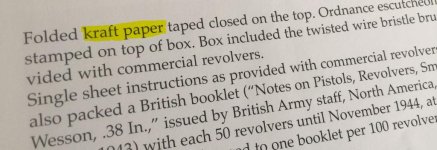Absalom
SWCA Member, Absent Comrade
I was just going through the bible for anyone interested in WW II-era US handguns, Charles Pate's book, and noticed that even he (or his proof-reader) couldn't quite decide whether US military handguns shipped in kraft boxes or craft boxes (see attached). A quick use of the forum's search function revealed that even among those here that are aware that those were indeed kraft boxes, a considerable percentage believes incorrectly they should be capitalized as Kraft boxes. So as a public service, here's the scoop.
If you want to call them craft boxes as a tribute to the craftsmanship involved in fabricating them, you may do so, but that's not where the name comes from.
It's also not Kraft boxes. Kraft is not a proper name here. James Kraft, who patented processed cheese in 1916, had nothing to do with the boxes, nor anyone else by that last name.
They are simply kraft boxes, after the kraft process, a wood pulping and paper making process developed in Germany in the 19th century; the word kraft derives from the German word for strength, as the resulting paper was particularly strong.
That's it. Class dismissed. Carry on.
If you want to call them craft boxes as a tribute to the craftsmanship involved in fabricating them, you may do so, but that's not where the name comes from.
It's also not Kraft boxes. Kraft is not a proper name here. James Kraft, who patented processed cheese in 1916, had nothing to do with the boxes, nor anyone else by that last name.
They are simply kraft boxes, after the kraft process, a wood pulping and paper making process developed in Germany in the 19th century; the word kraft derives from the German word for strength, as the resulting paper was particularly strong.
That's it. Class dismissed. Carry on.



